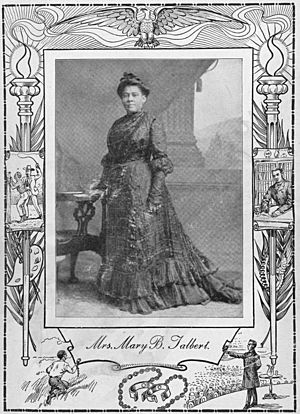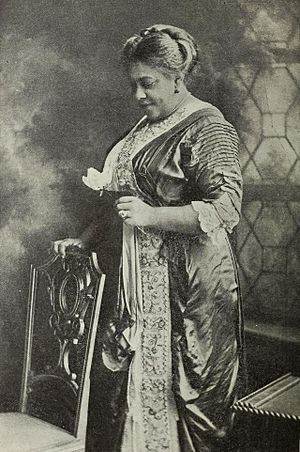Mary Burnett Talbert facts for kids
Mary Burnett Talbert (born Mary Morris Burnett; September 17, 1866 – October 15, 1923) was an important American activist, speaker, and suffragist. A suffragist is someone who worked to get voting rights for women. She also worked to make society better for everyone. In 2005, Mary Talbert was honored by being added to the National Women's Hall of Fame.
Contents
Mary Talbert's Life and Work
Early Life and Education
Mary Morris Burnett was born in Oberlin, Ohio in 1866. She went to Oberlin College and graduated in 1886. She was the only African-American woman in her graduating class. She earned a Bachelor of Arts degree.
After college, Mary became a teacher in 1886 at Bethel University in Little Rock, Arkansas. In 1887, she became an assistant principal at Union High School in Little Rock, Arkansas. This was the highest job an African-American woman held in the state at that time.
In 1891, she married William H. Talbert. They moved to Buffalo, New York. There, she joined the historic Michigan Avenue Baptist Church.
Fighting for Rights
Mary Talbert got a college degree when it was very rare for women and people of color to go to college. She believed that women of all races should work together. This was important because many women's groups were separated by race back then.
People called her "the best-known colored woman in the United States." She used her education to fight against lynching (when a mob kills someone, often by hanging, without a legal trial) and racism. Racism is unfair treatment or beliefs against people because of their race. She also supported women's right to vote.
In 1915, she spoke at a special event in Washington, D.C., called "Votes for Women: A Symposium by Leading Thinkers of Colored Women." She traveled around the country and the world. She told people about the difficult lives of African-Americans and why new laws were needed to help them.
Leading Civil Rights Efforts
Mary Talbert was a founder of the Niagara Movement. This group helped start organized civil rights work in America. The Niagara Movement was very important. It helped prepare the way for the National Association for the Advancement of Colored People (NAACP).
Mary Talbert was a key part of both groups. Her work helped set the stage for the big civil rights changes in the 1950s and 1960s. She also led many women's clubs for a long time. This helped develop black women's groups and leaders in New York and across the United States.
Saving History
Mary Talbert helped save the home of Frederick Douglass in Anacostia, D.C. Frederick Douglass was a famous abolitionist and writer. Other efforts to save his home had failed.
The Michigan Street Baptist Church in Buffalo, where the Talbert family went, is now a historic place. Many important African-Americans worshipped or spoke there. The church was also very important in the fight against slavery. In 1998, a special marker honoring Mary Talbert was placed in front of the church. She had served as the church's treasurer.
Honors and Legacy
In October 2005, Mary Talbert was inducted into the National Women's Hall of Fame in Seneca Falls, New York. Many clubs and buildings are named after her, including:
- Branches of the National Association of Colored Women's Clubs (NACW) in Buffalo, Detroit, Gary, and New Haven.
- City Federations of Women's Clubs in Florida and Texas.
- Talbert Hall at the University at Buffalo.
- Talbert Mall Housing Development (now Frederick Douglass Towers) in Buffalo.
- Mary B. Talbert Hospital in Cleveland, Ohio.
Mary Talbert passed away on October 15, 1923. She is buried in Forest Lawn Cemetery (Buffalo).
Key Achievements
Mary Talbert achieved many great things in her life:
- She started the Christian Culture Congress in 1901. This was a group for learning and discussion. It brought Black leaders like W. E. B. Du Bois to speak in Buffalo.
- She protested when Black people were left out of the planning for the 1901 Pan-American Exposition. Because of her efforts, a "Negro Exhibit" was included. It showed the cultural and economic achievements of African Americans.
- She joined the Phillis Wheatley Club, which was the first club in Buffalo to join the NACWC. She later became its president.
- She helped start the Niagara Movement. This group was a very early step toward the NAACP. It marked the beginning of civil rights activism in the 20th century.
- She helped create Buffalo's first NAACP chapter in 1910. She also helped start NAACP chapters in Texas and Louisiana. She became a board member and vice president of the NAACP.
- In 1921, she was the National Director of the NAACP Anti-Lynching Campaign.
- She was the eighth person, and the first woman, to receive the Spingarn Medal. This is the highest honor given by the NAACP.
- During World War I, she worked as a secretary for the YMCA in France. She taught classes to African-American soldiers. She also sold thousands of dollars in Liberty Bonds as a traveling speaker.
- She was chosen to be on the Women's Committee on International Relations. This committee picked women for jobs in the League of Nations.
- She was a founding member of the Empire State Federation of Colored Women. She later served as its president.
- She was elected President of the NACWC from 1916 to 1921.
- In 1920, she was the first African-American delegate to the International Council of Women (ICW) meeting in Norway.
- She helped restore the Frederick Douglass home in Washington, D.C. She was elected president-for-life of the Frederick Douglass Memorial and Historical Association.
- She gave talks in 11 European countries about the lives of African-Americans in the United States. Her speeches received a lot of attention from the press.
- In 1922, she co-founded the International Council of Women of the Darker Races in Washington, D.C.
- She was the first Worthy Matron of Naomi Chapter No.10 Prince Hall Order Eastern Star in New York.



